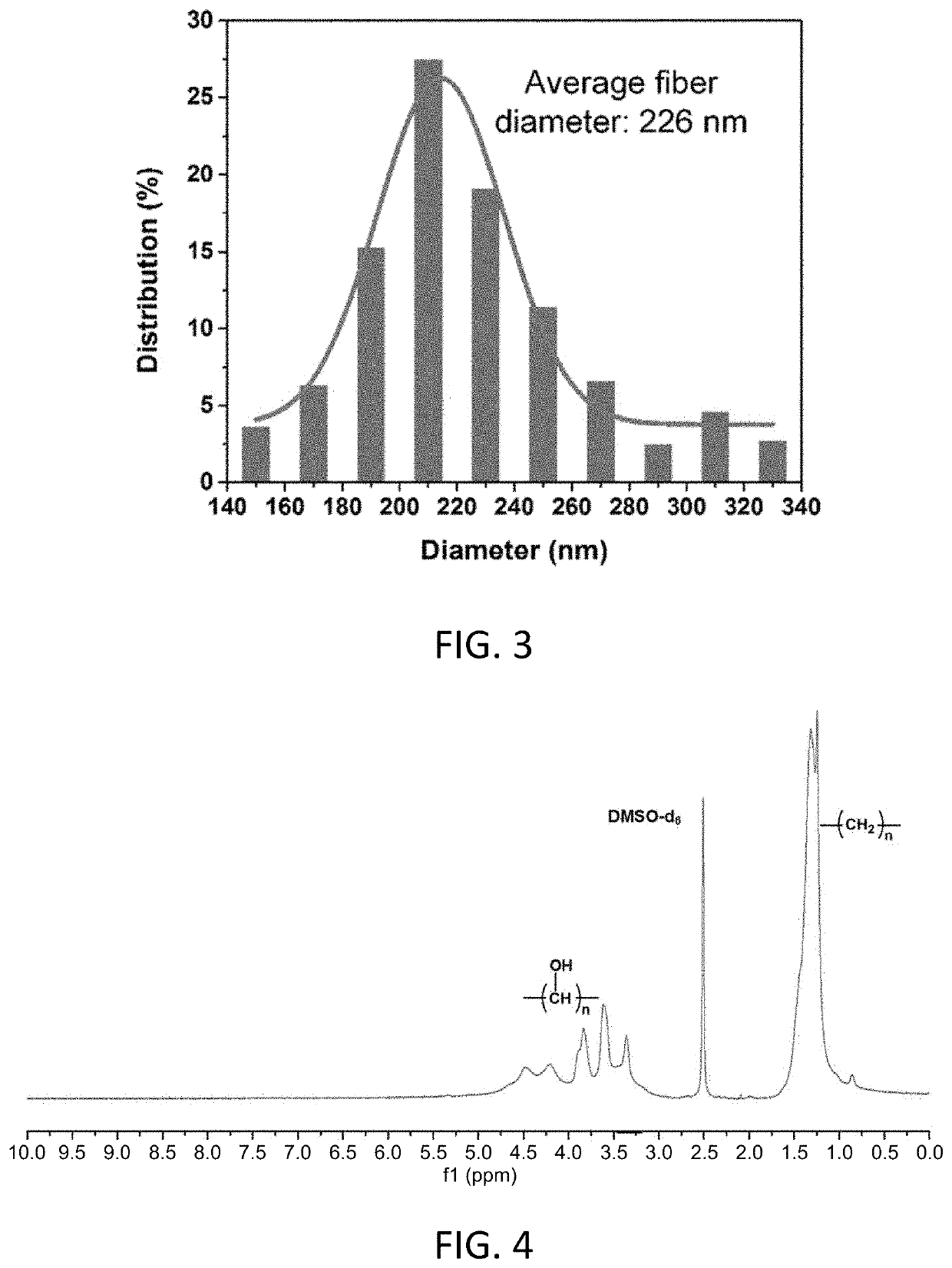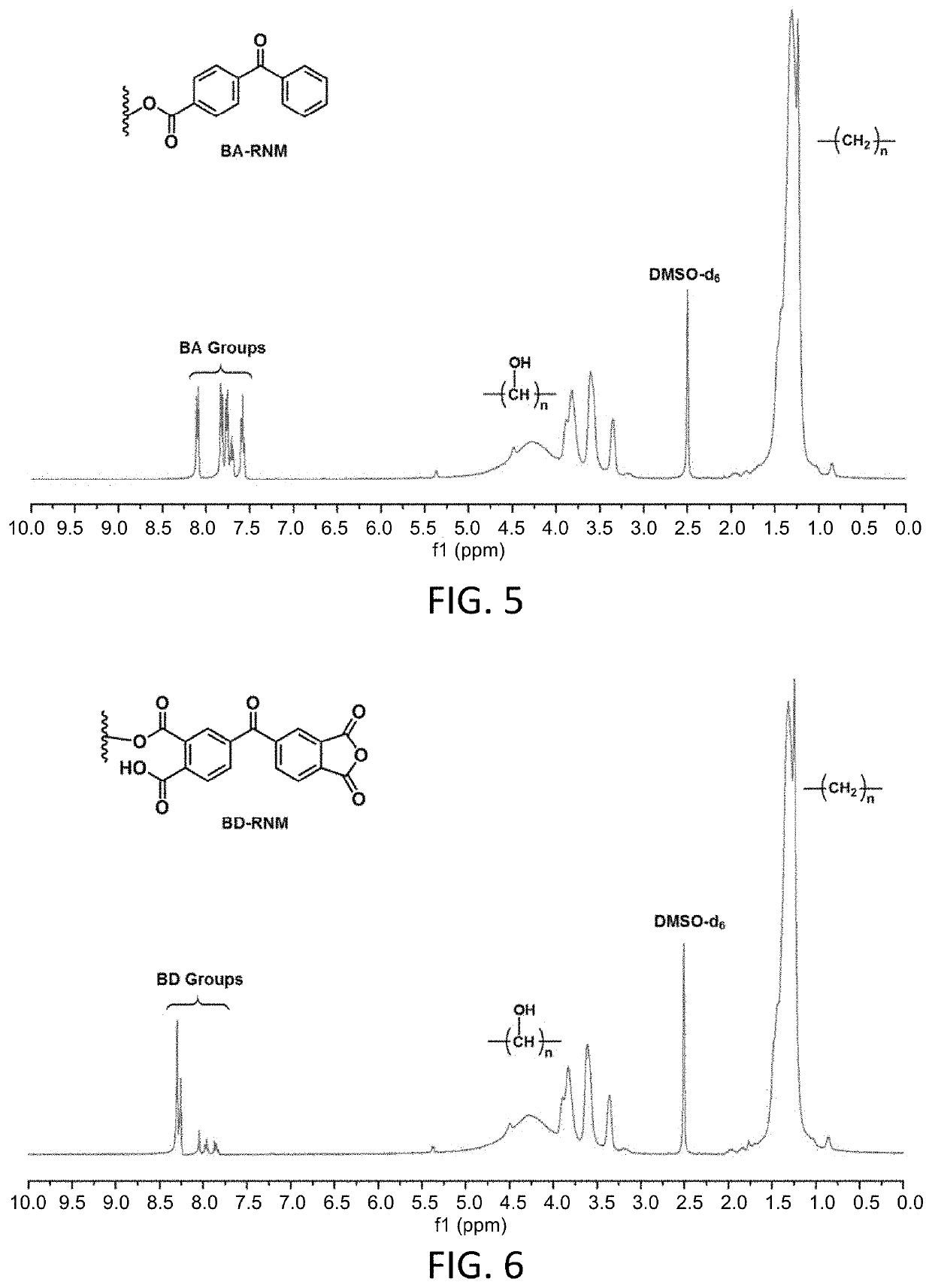Biocidal solar cell
a solar cell and biocidal technology, applied in the field of antibacterial and antiviral materials and methods, can solve the problems of increased infection risk, inability to completely eliminate the associated risk of infection, and high risk of eid acquisition during the care of patients, and achieves robust photo-activity, increased ros, and robust utilization of daylight sources.
- Summary
- Abstract
- Description
- Claims
- Application Information
AI Technical Summary
Benefits of technology
Problems solved by technology
Method used
Image
Examples
example 1
on of Nanofiber Networks and Membranes
[0136]FIG. 1 illustrates the synthesized structures that included two classes of benzophenone with different substitutes (4-benzoylbenzoic acid (BA) and benzophenone tetracarboxylic dianhydride (BD)), a natural polyphenol (chlorogenic acid (CA)), and a novel compound of benzophenone tetracarboxylic acid with chlorogenic acid (BDCA). Poly (vinyl alcohol-co-ethylene) (PVA-co-PE) was used as a polymer precursor and hydrogen donor to construct the nanofibrous networks. The fabrication began with the electrospinning production of PVA-co-PE nanofibrous membranes (FIG. 2) having an average fiber diameter of 226 nm (FIG. 3). Subsequently, grafting reactions were carried out by immersing the membranes in a tetrahydrofuran solution with various photosensitizers, and esterification reactions between the hydroxyl groups on the membrane and carboxyl groups on the agents were catalyzed by carbonyldiimidazol (FIGS. 4-7). Thereafter, the resulting membranes wer...
example 2
Effects of Rechargeable Nanofiber Membranes
[0138]FIG. 12 illustrates the biocidal effect of RNMs against pathogenic microbes. Once the pathogens are intercepted and in contact with the surface of the nanofibers, the grafted photo-biocides can display an intrinsic biocidal activity as free chemicals. In the presence of oxygen, various ROS including hydroxyl radicals (.OH), superoxide (.O2—), and hydrogen peroxide (H2O2) are produced continuously. ROS can further rapidly damage DNA, RNA, proteins, and lipids, resulting in bacterial death and virus inactivation.
[0139]Without intending to limit the invention, a proposed mechanism for the photo-active and photo-storable biocidal functions is illustrated in FIGS. 13 and 14. The initial photo-reaction hinges on the ability of the photo-excited RNM to access the triplet excited state (3RNM*) via intersystem crossing (ISC), which can be of local excitation or charge transfer character, depending on the relative configuration of the π* orbita...
example 3
n Features of RNMs
[0140]To provide insight into the excitation features of the RNMs, time-dependent density functional theory (TD-DFT) calculations and diffuse reflection UV-vis spectroscopy were used to evaluate the nature of the initial photoexcitation event. From Table 1, The TD-DFT calculations of the RNMs predict that the lower energy S0→S1 excitations are dominantly dark with very weak oscillator strength. Meanwhile, the S0→Sn excitations of the RNMs are predicted to be bright, and the calculated maximum wavelength (λmax) matched with the measured UV-vis spectra, as shown in FIG. 15. The λmax of BA-RNM, BD-RNM, CA-RNM, and BDCA-RNM were 275, 307, 336, and 332 nm, respectively. Although these λmax values were mainly located in UV range, compared with the standard spectrum of D65 daylight, light energy in the range from 300 to 450 nm can be still readily utilized by the RNMs, as shown in FIG. 16. The estimated daylight absorbance coefficients for BA-RNM, BD-RNM, CA-RNM, and BDCA...
PUM
| Property | Measurement | Unit |
|---|---|---|
| Thickness | aaaaa | aaaaa |
| Thickness | aaaaa | aaaaa |
| Diameter | aaaaa | aaaaa |
Abstract
Description
Claims
Application Information
 Login to View More
Login to View More - R&D
- Intellectual Property
- Life Sciences
- Materials
- Tech Scout
- Unparalleled Data Quality
- Higher Quality Content
- 60% Fewer Hallucinations
Browse by: Latest US Patents, China's latest patents, Technical Efficacy Thesaurus, Application Domain, Technology Topic, Popular Technical Reports.
© 2025 PatSnap. All rights reserved.Legal|Privacy policy|Modern Slavery Act Transparency Statement|Sitemap|About US| Contact US: help@patsnap.com



